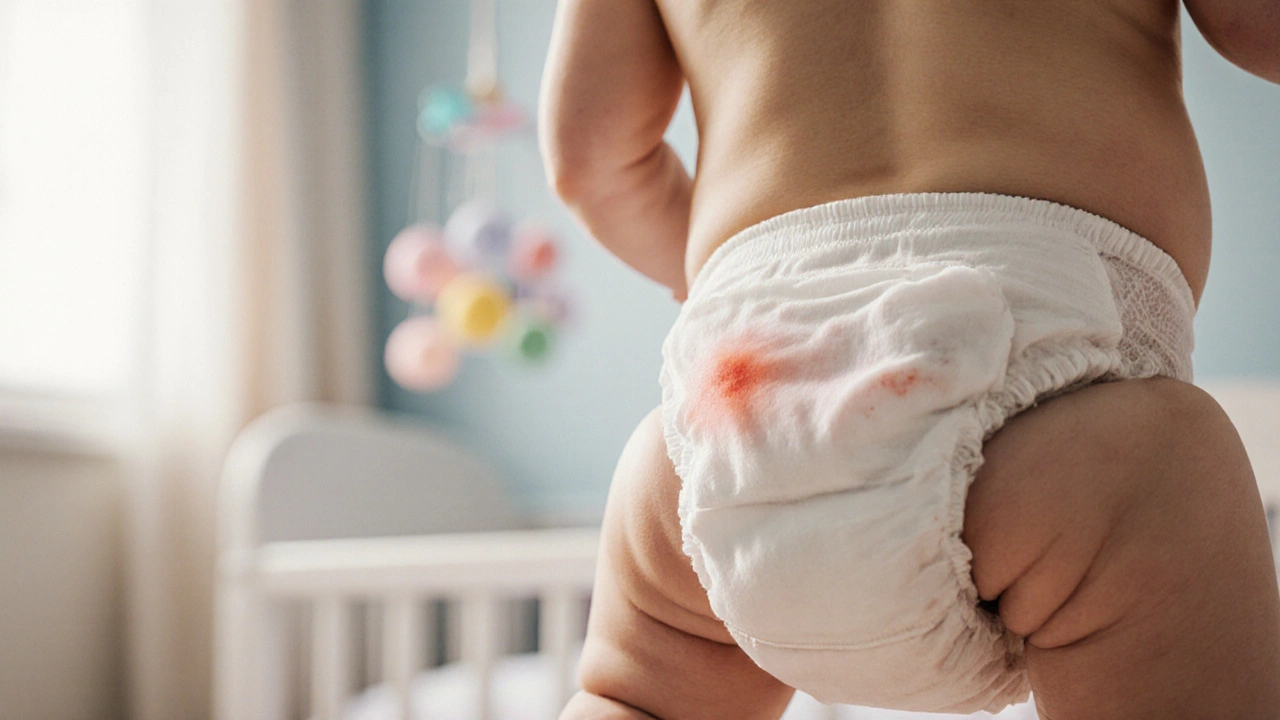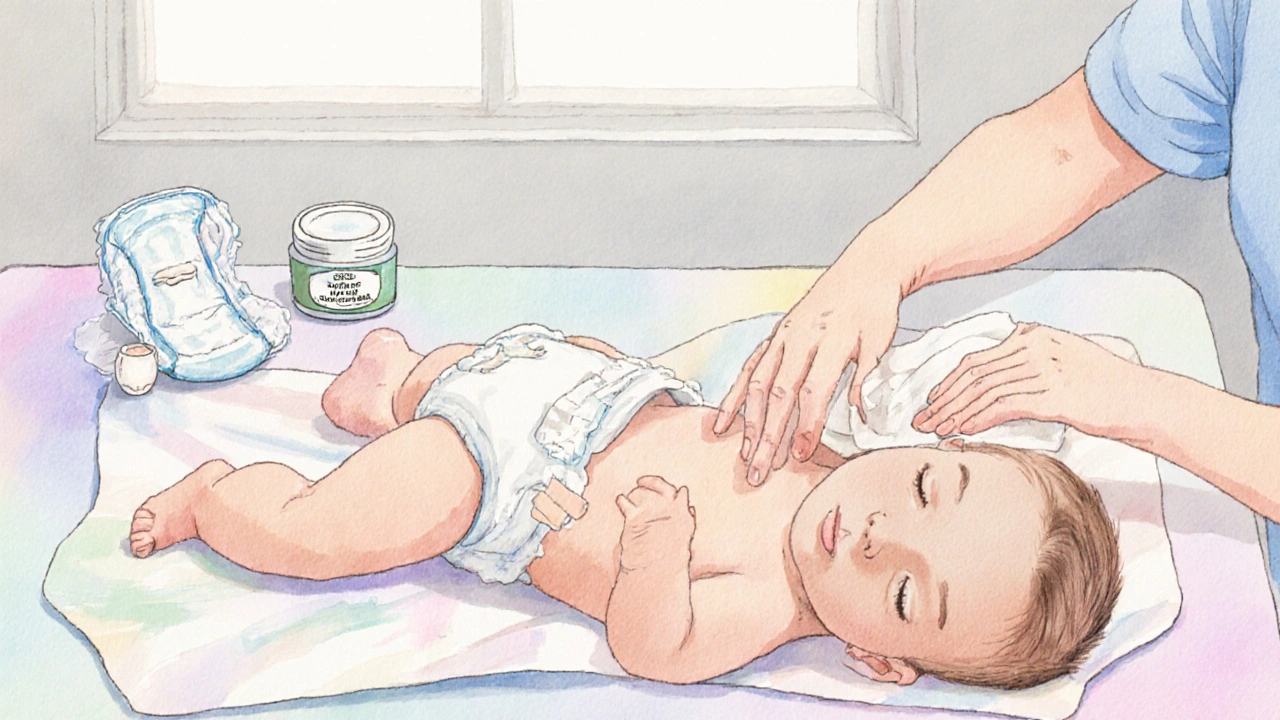
Diaper Change Safety Checker
When it comes to Diaper rash in premature babies a common irritation that appears on the delicate skin of infants born before full term, extra attention is needed to keep the area healthy, the stakes are higher than with full‑term infants. Understanding why the rash shows up, how to stop it before it starts, and what to do if it does appear can make all the difference for both baby and parents.
Key Takeaways
- Premature infants have thinner, more sensitive skin and a weaker skin barrier.
- Frequent diaper changes, breathable diapers, and a gentle barrier ointment are the core prevention steps.
- Watch for signs of infection-bright red patches, blisters, or a foul smell-and call a pediatrician promptly.
- Choose products specifically labeled for preterm or newborn skin to avoid harsh chemicals.
- When in doubt, trust a healthcare professional; self‑treatment should stay gentle and short‑term.
Why Premature Babies Are Prone to Diaper Rash
A Premature infant is a baby born before 37 weeks of gestation, often with more delicate skin and an under‑developed immune system faces three main skin challenges:
- Thin epidermis: The outer layer of skin (stratum corneum) is thinner, reducing natural protection against moisture and friction.
- Imbalanced pH: Newborn skin is naturally slightly acidic (pH 5.5). In preemies, this acidity can be less stable, making the skin more vulnerable to the alkaline nature of urine.
- Immature microbiome: Beneficial bacteria that help fend off harmful microbes are still establishing themselves, so opportunistic infections like Candida infection a yeast overgrowth that thrives in warm, moist environments can take hold quickly.
Because of these factors, the simple act of a wet diaper can quickly become a breeding ground for irritation.

Core Prevention Strategies
Think of diaper care as a short routine that you repeat every few hours. Here’s a step‑by‑step approach that works for most parents:
- Change diapers promptly: Aim for every 2-3 hours, or immediately after a bowel movement. The longer urine sits, the more it raises the skin’s pH.
- Gently cleanse: Use warm water and a soft, lint‑free cloth or a fragrance‑free, alcohol‑free wipe. Pat dry-don’t rub.Apply a barrier: Barrier ointment a thin layer of zinc oxide, petroleum, or dimethicone that shields skin from moisture should be spread in a thin film after each change.
- Give skin air time: If possible, let the baby go diaper‑free for 10-15 minutes a few times a day. Fresh air helps restore the skin’s natural barrier.
- Use breathable diapers: Choose products designed for preterm babies that feature a cotton‑rich liner or a breathable outer shell.
These steps cut down on moisture, friction, and the exposure to irritants that cause rash.
Choosing the Right Diaper and Skin Products
Not all diapers are created equal. Below is a quick comparison of the two main types most parents consider for preemies.
| Type | Material | Breathability | Absorbency | Recommended for |
|---|---|---|---|---|
| Disposable (preemie‑specific) | Soft, hypoallergenic non‑woven fibers with a breathable back sheet | High (air‑flow channels) | Moderate (designed for low output) | First few weeks, especially in NICU settings |
| Cloth (organic cotton) | 100% organic cotton layers | Very high (natural fibers) | High (when used with absorbent inserts) | Older preemies who have gained weight and can tolerate longer wear times |
For the earliest weeks, a well‑designed disposable diaper often wins because it reduces the risk of prolonged moisture exposure. As the baby grows and you’re comfortable with longer change intervals, a soft cloth diaper can be a gentle, eco‑friendly alternative.
When picking any product, look for these labels:
- "Fragrance‑free" and "hypoallergenic"
- "Dermatologist tested" or "pediatrician recommended"
- No added lotions or powders inside the diaper

How to Treat a Rash Safely at Home
If a rash does appear, stay calm and follow these steps before calling for help:
- Keep the area clean: Wash gently with lukewarm water, then pat dry.
- Apply a thin layer of barrier ointment: Stick to zinc‑oxide based ointments; they create a protective film without heavy oils that could trap moisture.
- Switch diaper brands: Sometimes a change in material can halt worsening.
- Avoid creams with steroids unless prescribed by a Pediatrician a child‑focused medical doctor who can diagnose and prescribe appropriate treatments. Overuse can thin the skin.
- Monitor for infection: Look for pus, yellow crusts, or a distinct yeast‑like smell-signs that a Bacterial infection an invasion of harmful bacteria such as Staphylococcus aureus that can complicate a simple rash may be developing.
Most mild rashes improve within 48-72 hours with these measures. If you see any of the red‑flag symptoms, move to the next section.
Red Flags: When to Call a Doctor
Premature skin can deteriorate fast, so watch for these tell‑tale signs that need professional care:
- Rash spreads beyond the diaper area (groin, abdomen, thighs).
- Blisters, ulcerations, or open sores appear.
- The baby seems unusually fussy during diaper changes.
- Fever of 100.4°F (38°C) or higher accompanies the rash.
- Persistent foul odor or thick, yellow crusts suggest a yeast or bacterial overgrowth.
If any of these show up, contact your pediatrician or the NICU team right away. Early treatment with prescription‑strength ointments or antifungal drops can prevent a small irritation from turning into a serious infection.
Frequently Asked Questions
How often should I change a preemie’s diaper?
Aim for every 2-3 hours, and always right after a bowel movement. Wetness left for longer than 4 hours significantly raises the risk of rash.
Is it safe to use baby powder on a premature baby’s diaper area?
No. Powder can carry talc or cornstarch particles that irritate the lungs if inhaled and can also trap moisture, worsening a rash.
Can a diaper rash cause a fever?
A simple rash usually does not cause fever. If the baby develops a temperature, it likely signals an infection and should be evaluated promptly.
What ingredients should I look for in a barrier ointment?
Zinc oxide (10-15%) is the gold standard. It forms a protective shield without feeding bacteria. Avoid ointments with added fragrances, lanolin, or petroleum jelly in high‑shrink preemies.
Should I use cloth diapers once my baby reaches a certain weight?
Many parents switch to cloth when the baby is around 4-5 pounds and can tolerate longer intervals between changes. Always pair cloth diapers with a breathable liner and change frequently.
Comments (19)
-
Kevin Galligan October 12, 2025
Well, that’s a lot of baby science for me 😏
-
Dileep Jha October 15, 2025
When addressing diaper dermatitis in neonates, especially those born preterm, one must first consider the cutaneous barrier's transepidermal water loss coefficient.
The etiopathogenesis often involves an interplay between maceration, enzymatic activity of fecal proteases, and occlusive humidity gradients.
A prophylactic regimen should therefore incorporate a semi-permeable polymeric film that modulates vapor transmission rate.
Clinicians frequently prescribe zinc oxide ointments, but the colloidal dispersion size can alter the occlusive index dramatically.
Emerging literature highlights the utility of lanolin-free emollients to mitigate allergenic potential in the immunologically naïve infant.
From a pharmacokinetic perspective, the percutaneous absorption of barrier agents is negligible, yet the vehicle's rheology influences spreadability.
A systematic review of randomized controlled trials indicates that a change interval exceeding three hours correlates with a statistically significant increase in erythema scores (p < 0.01).
Therefore, integrating a digital hourglass or a smartphone reminder can operationalize the recommended change cadence.
In addition, barrier creams should be applied to a dry perineal area to prevent dilution of the active layer.
If fungal colonization is suspected, topical clotrimazole 1 % offers a synergistic effect when combined with the occlusive barrier.
It is also prudent to avoid scented wipes, as fragrance compounds can act as irritants via the Toll‑like receptor pathway.
From a metabolic standpoint, the thermogenic load imposed by excessive layering can exacerbate insensible water loss in very low birth weight infants.
Hence, clinicians should balance thermal regulation with diaper absorbency to maintain normothermia.
When severe erythema progresses to ulceration, a consult with pediatric dermatology is warranted to rule out secondary bacterial infection.
In summary, a multimodal strategy encompassing optimal change frequency, judicious barrier selection, and vigilant monitoring constitutes best practice for mitigating diaper rash in premature cohorts.
-
Michael Dennis October 17, 2025
It appears the article attempts to cover a broad spectrum of preventative measures, yet the depth of discussion remains superficial. The recommendation to “check the safety” lacks actionable detail, which might mislead caregivers seeking concrete guidance. Additionally, the absence of references to clinical guidelines reduces the credibility of the content.
-
Blair Robertshaw October 20, 2025
yeah, but u really think anyone reads that fluff? most parents just skim and miss the “check safety” button, lol.
-
Alec Maley October 23, 2025
Hey folks, I totally get how overwhelming diaper care can feel, especially with a preemie. Just remember that consistent, gentle cleaning and a breathable diaper choice go a long way. If you notice any persistent redness, a quick chat with your pediatrician can give you peace of mind.
-
Navjot Ghotra October 26, 2025
i guess thats it but honestly its just common sense dont need a whole article for it
-
Claus Rossler October 29, 2025
While many herald the “three‑hour rule” as gospel, recent data suggests that infant skin microbiota may actually benefit from longer moisture exposure, challenging the conventional wisdom.
-
chris mattox November 1, 2025
That’s an intriguing point! 🧪 Let’s remember that every baby’s skin is unique, so a flexible approach-perhaps testing a few intervals and observing the outcome-can empower parents to find what truly works for their little one.
-
Jackson Whicker November 4, 2025
Honestly, if you’re still relying on generic diaper rash tips, you’re doing your child a disservice; only evidence‑based protocols deserve a place in the nursery.
-
parag mandle November 7, 2025
While I respect the push for rigor, it’s vital to balance strict protocols with compassionate care; overly aggressive regimens can strip the skin of its natural defenses, paradoxically increasing susceptibility.
-
Shivali Dixit Saxena November 10, 2025
Let’s keep it simple: change often, keep it dry, and apply a gentle barrier-your baby will thank you!
-
Sayam Masood November 13, 2025
In the grand tapestry of infancy, even the smallest ritual of a diaper change echoes the eternal dance between entropy and order; thus, mindful timing becomes a subtle act of cosmic stewardship.
-
Jason Montgomery November 15, 2025
Yo, kudos to everyone sharing tips-remember, consistency is key, but don’t stress if you miss a change now and then. The goal is a happy, comfy baby, not perfection.
-
Wade Developer November 18, 2025
One might argue that the pursuit of an optimal diaper change schedule reflects a deeper human desire to impose structure upon the inherently chaotic nature of early development.
-
rama andika November 21, 2025
Sure, the “official” guidelines are fine-until you realize they’re secretly funded by the diaper industry to keep us buying their super‑absorbent, chemical‑laden products.
-
Kenny ANTOINE-EDOUARD November 24, 2025
While it’s easy to suspect ulterior motives, the consensus among pediatric dermatologists remains grounded in independent research; selecting an unscented, low‑absorbency option can still reduce rash risk without buying into conspiracy narratives.
-
Tracy Winn November 27, 2025
Honestly, folks-if you’re still using wipes with alcohol, stop it now!!! That’s a recipe for irritation, especially on delicate pre‑term skin.
-
Jessica Wheeler November 30, 2025
It’s not just about the wipes, it’s about a holistic ethic of gentlness; we have a moral duty to treat infant skin with the same reverence we afford any sentient being.
-
Mikayla Blum December 3, 2025
Bottom line: keep it clean, keep it dry, keep it comfy-simple, right? 😃
